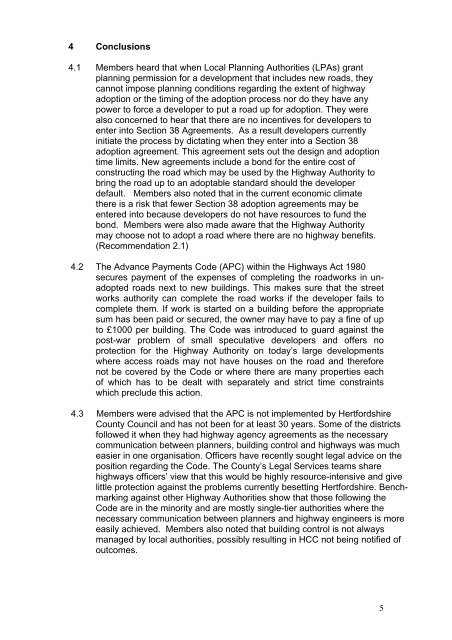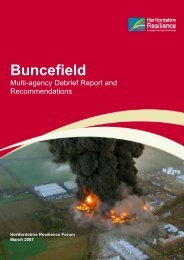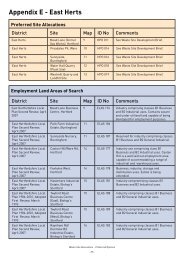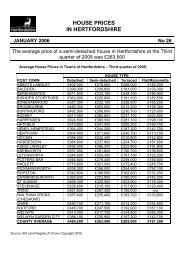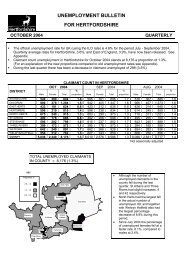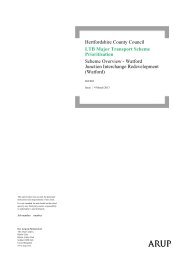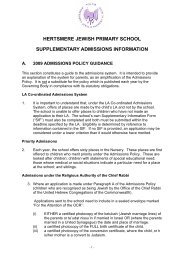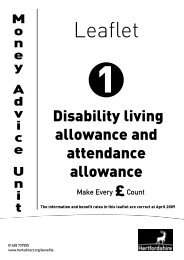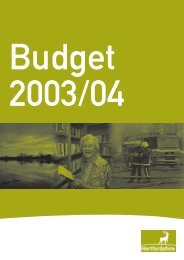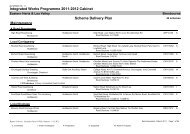26-Mar-10 - Hertfordshire County Council
26-Mar-10 - Hertfordshire County Council
26-Mar-10 - Hertfordshire County Council
You also want an ePaper? Increase the reach of your titles
YUMPU automatically turns print PDFs into web optimized ePapers that Google loves.
4 Conclusions<br />
4.1 Members heard that when Local Planning Authorities (LPAs) grant<br />
planning permission for a development that includes new roads, they<br />
cannot impose planning conditions regarding the extent of highway<br />
adoption or the timing of the adoption process nor do they have any<br />
power to force a developer to put a road up for adoption. They were<br />
also concerned to hear that there are no incentives for developers to<br />
enter into Section 38 Agreements. As a result developers currently<br />
initiate the process by dictating when they enter into a Section 38<br />
adoption agreement. This agreement sets out the design and adoption<br />
time limits. New agreements include a bond for the entire cost of<br />
constructing the road which may be used by the Highway Authority to<br />
bring the road up to an adoptable standard should the developer<br />
default. Members also noted that in the current economic climate<br />
there is a risk that fewer Section 38 adoption agreements may be<br />
entered into because developers do not have resources to fund the<br />
bond. Members were also made aware that the Highway Authority<br />
may choose not to adopt a road where there are no highway benefits.<br />
(Recommendation 2.1)<br />
4.2 The Advance Payments Code (APC) within the Highways Act 1980<br />
secures payment of the expenses of completing the roadworks in unadopted<br />
roads next to new buildings. This makes sure that the street<br />
works authority can complete the road works if the developer fails to<br />
complete them. If work is started on a building before the appropriate<br />
sum has been paid or secured, the owner may have to pay a fine of up<br />
to £<strong>10</strong>00 per building. The Code was introduced to guard against the<br />
post-war problem of small speculative developers and offers no<br />
protection for the Highway Authority on today’s large developments<br />
where access roads may not have houses on the road and therefore<br />
not be covered by the Code or where there are many properties each<br />
of which has to be dealt with separately and strict time constraints<br />
which preclude this action.<br />
4.3 Members were advised that the APC is not implemented by <strong>Hertfordshire</strong><br />
<strong>County</strong> <strong>Council</strong> and has not been for at least 30 years. Some of the districts<br />
followed it when they had highway agency agreements as the necessary<br />
communication between planners, building control and highways was much<br />
easier in one organisation. Officers have recently sought legal advice on the<br />
position regarding the Code. The <strong>County</strong>’s Legal Services teams share<br />
highways officers’ view that this would be highly resource-intensive and give<br />
little protection against the problems currently besetting <strong>Hertfordshire</strong>. Benchmarking<br />
against other Highway Authorities show that those following the<br />
Code are in the minority and are mostly single-tier authorities where the<br />
necessary communication between planners and highway engineers is more<br />
easily achieved. Members also noted that building control is not always<br />
managed by local authorities, possibly resulting in HCC not being notified of<br />
outcomes.<br />
5


